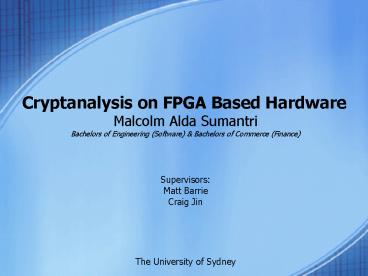Cryptanalysis on FPGA Based Hardware PowerPoint PPT Presentation
1 / 12
Title: Cryptanalysis on FPGA Based Hardware
1
Cryptanalysis on FPGA Based Hardware
Malcolm Alda SumantriBachelors of Engineering
(Software) Bachelors of Commerce (Finance)
SupervisorsMatt BarrieCraig Jin
The University of Sydney
2
Introduction
- Welcome to the Digital Age where everything can
be replicated! - Cryptography is used
- To protect our privacy
- For example our real identity, our e-mails to
family and friends, our digital photos, our work. - To protect corporate secrets
- For example future corporate strategies,
intellectual property, pricing information, human
resources information. - By governments
- For example sending messages to spies, task
forces, between agencies to protect civilians and
against terrorism. - How secure are our currently deployed
cryptosystems?
3
Motivation
- Information security is a resource game.
- More funds means more access to information.
- The US National Security Agencys annual budget
is classified but is said to be over US 13
billion. - Assessing the strength of our cryptosystems
therefore involves determining the cost to break
them. - Rapid development in Field Programmable Gate
Array Technology (FPGA) technology that makes it
cheaper to develop high-performance custom
hardware systems. FPGA technology has proven to
be effective for cryptographic use. - A recent optimization in cryptanalysis.
- Rainbow Tables
4
Background
- Symmetric Cipher
- Cryptanalysis Code breaking, reveal the
plaintext without the key. - Exhaustive Key Search Try every key possible,
requires large computational power. - Table Lookup Store keys and ciphertexts in a
massive tables to perform a lookup when trying to
attack, requires a large amount of memory
(infeasible). - Time-memory trade-off Give up memory to achieve
a faster attack time. - FPGAs
- Reconfigurable logic (upload the bitstream to the
hardware). - Cheaper than Application Specific Integrated
Circuits (ASICs) for small volumes.
5
Time-Memory Trade-OffRainbow Tables
- How does it work?
- Assume a chosen-plaintext attack scenario.
- The attacker can choose which plaintext to
access. - This attacker will use this to attack the
cryptosystem. - This is practical in the real-world (UNIX
password hashing, include ltstdio.hgt, \n) - Two Phases
- Precomputation Phase
- Online Attack Phase (Cryptanalytic Attack)
- Precomputation Phase Generate a rainbow table.
- A rainbow table is a two-column table
(start-point, end-point) - These points are possible keys.
- This table is generated by a specific algorithm.
- Online Attack Phase Use the rainbow table.
- We are given a ciphertext to break.
- Now we perform a search on the rainbow table by
using another algorithm - This method is probabilistic, but faster than
exhaustive key search.
6
Methodology
- Design and implement an FPGA based cryptanalytic
system that uses the rainbow tables method of
cryptanalysis. - Use the Data Encryption Standard (DES) as the
test symmetric cipher. - DES uses a 56-bit key.
- DES is the most widely studied cipher.
- DES is still used today (UNIX password hashing).
- Determine the cost to break DES.
- Extrapolate the cost to break other ciphers.
7
Design I Data Encryption Standard
- In designing a cryptanalytic system, the
performance of the cipher module will determine
the performance. - Security of DES derives from 16 rounds of
permutations, substitutions and xoring. - Each round is implemented as a 3-stage pipeline.
A total of 48-stages for the 16 rounds of DES. - Pipelining improves performance
- Attain higher clock frequencies.
- Achieve parallelization 48 encryptions per
clock cycle.
8
Design II The Rainbow Table
Precomputation System
1. High Level System Design
2. Hardware Design
3. Hardware output behavior (Timing Diagram)
9
Design III The Rainbow Table
Online Attack System
1. High Level System Design
2. Hardware Design
3. Mechanism
10
Experiment and Results
- Experiment
- Cryptanalytic attack on 40-bit DES since the
resources to break DES is out-of-reach for the
budget in this thesis. - Use Sensory NetworksTM NodalCoreTM C-1000 PCI
Card. - Xilinx Virtex-II Pro VP-40 FPGA
- Flexible chipset architecture to embed our
hardware engines. - PCI interface allows for high-speed
communications.
- Results
- 40-bit DES Rainbow Table can be generated in less
than 4 hours. Table parameters allows for 85
cryptanalytic success probability. - Fastest known implementation in the literature
based on results. - Online attack of 40-bit DES in 30.8 seconds.
11
Data Analysis
- Performance-Cost Analysis
- Determine the FPGA chip that provides the highest
performance for the lowest cost. - Synthesized the hardware designs for various
Xilinx FPGAs. - Spartan 3 S-1500 provides the highest
performance-cost relative to other Xilinx FPGA
chips. - Extrapolate the design of a machine to break DES
(56-bit key length) - Result DES can be broken with 85 success
probability in 72 minutes for an approximate cost
of US 1,210.
Performance-Cost of Precomputation Hardware System
12
Conclusion
- FPGAs provides a low cost and effective solution
to cryptanalysis. - Rainbow table attacks provide a faster attack
time compared to brute-force, but brute-force
uses less resources, that is, memory resources. - For large key sizes, the rainbow table attack
becomes infeasible as memory costs is prohibitive.

